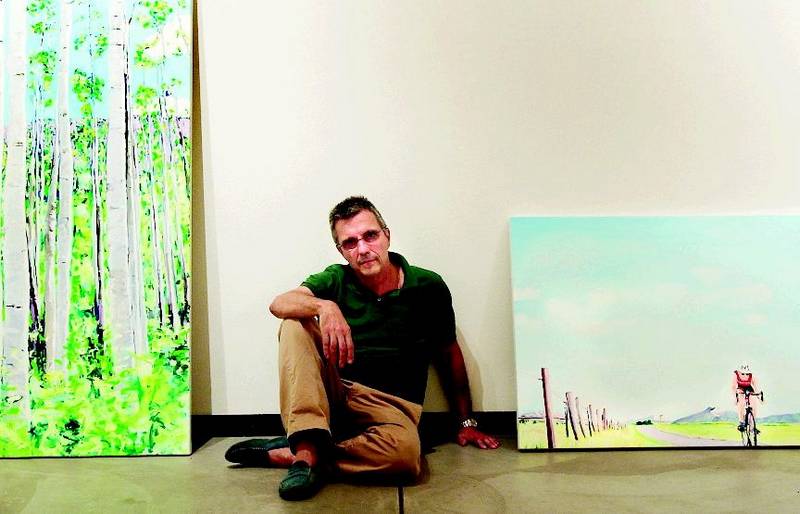Billy Sullivan: into the here and now

ALL |
David Salle’s exhibit of new paintings in the upstairs space of the Baldwin Gallery reflect a measure of contemplation, deliberation and time-taking. Most of the pieces combine several discreet images on one canvas: “Drunk Bottles,” for instance, contains side-by-side depictions of fish, wine bottles and a shapely naked woman, the idea seeming to be for the viewer to conjure connections between the objects. The exhibit also includes several of Salle’s new “spin” paintings, which use computers to “spin” Salle’s painted images in what one assumes is a thought-intensive process.There’s no such lack of immediacy in the work of Billy Sullivan, another New York painter whose new series, “Aspen Portrait,” is featured downstairs in the Baldwin Gallery. Sullivan’s paintings reflect the world as he sees it, with little energy given to conceptualizing, categorizing or considering.”My work is diaristic,” said Sullivan, a 57-year-old bundle of wiry energy. “My work is about my life. So it’s wherever I am, whatever I’m interested in. It keeps moving. It’s a visual absorption. I zoom in and do it.”Last summer Sullivan visited Aspen, and did what he always does – whether at his studio in the Bowery in lower Manhattan or in his second studio in East Hampton, or taking in the New York nightlife he loves, and traveling to Los Angeles, or Milan. He looked out, took photographs, and painted what he saw. So the current show is a slice of Aspen summer life as seen through the eyes of Sullivan. There are images of Aspen Music Festival rehearsals, student musicians playing on street corners, bikers and aspen trees. There are portraits of the people Sullivan met – Melva Bucksbaum and Raymond Learsy, and Lynda Resnick who, not coincidentally, are significant figures in the art world.
Sullivan’s process and end product are as straightforward as possible. But to Sullivan, the world seems to come to him in a constant buzz. In his five days here last summer, he estimates he shot 60 rolls of film, focusing not only on the people and activities but the light, the sounds, the colors and the mood. And he said the particular vibe of Aspen has an impact on the final paintings that would be different than if he were nightclubbing in Soho or sitting on the beach in the Hamptons.”It’s the whole thing. You’re sitting in it, absorbing it,” he said. “Here there’s the blue sky, the bubbling water, people who are constantly in motion. You’re bombarded with all that stuff: cocktail parties, health fanatics, dogs. All that stuff goes on around you and affects you. It’s a blitz.”After his visit here, Sullivan retreated to his East Coast studios to look at the images and see what grabbed his attention. If there is a element of thought that goes into his work, it takes place in the time between shooting film and sorting through the photographs. “I don’t know when I take the picture what’s going to push me over the edge and get me involved,” he said. The sense of immediacy in Sullivan’s work is matched by his direct attraction to art. Raised in the Sunset Park neighborhood of Brooklyn, Sullivan says his career direction was set before his teens.”Painting was it,” said Sullivan, who went to the High School of Art and Design, then the School of Visual Arts, both in his native New York. “I had to tell my parents I was studying advertising, because they wouldn’t give me money for school otherwise.
“I knew I was going to do this at 13. I knew there was nothing else I was equipped to do.”Sullivan was unconcerned in his formative years that painting was considered passé, supplanted by photography and conceptual art. And if that meant being outside the commercial mainstream, that was fine by him.”If you were interested in it, it was the right thing to do,” he said. “You didn’t go into it to be a success. You drove a taxi – and did your painting. I drove a taxi a few times. But I was driving a taxi and having shows. And I could drive a taxi and go to the clubs. A lot of my early work was about going out at night.”Sullivan’s work has been featured in The New York Times Magazine, for which he did an ambitious series of fashion drawings, and in the Jack Nicholson/Helen Hunt comedy “As Good As It Gets,” for which he served as art advisor and had several of his paintings and drawings featured. But Sullivan hardly needs such high-profile placement to motivate him to make art. Anything that passes his eyes can be turned into a painting; in the world of Billy Sullivan, there seems to be no such thing as the mundane.
“I’d do a work and someone would like it and they’d say, could you paint my dog? And I’d have no issue,” he said. “I enjoy doing portraits. I love people. And it’s always different. It could be the person sitting next to me in a restaurant. It could be sitting on the beach. It could be gazing out my window.”Finally, Sullivan takes a second to reflect on his particular form of artistry. And he concludes that there is an aspect of concept and contemplation in what he does.”It’s about a moment. But it’s about my own personal moment,” he said. “Sometimes the moment takes a long time to capture.”Stewart Oksenhorn’s e-mail address is stewart@aspentimes.com
State golf: Persson, Aspen girls in third place after Day 1 at the Olde Course
The Aspen High School girls golf team finished Day 1 of the Class 3A state championships on Monday in third place, with two players sitting in the top 10 at the Olde Course in Loveland.









